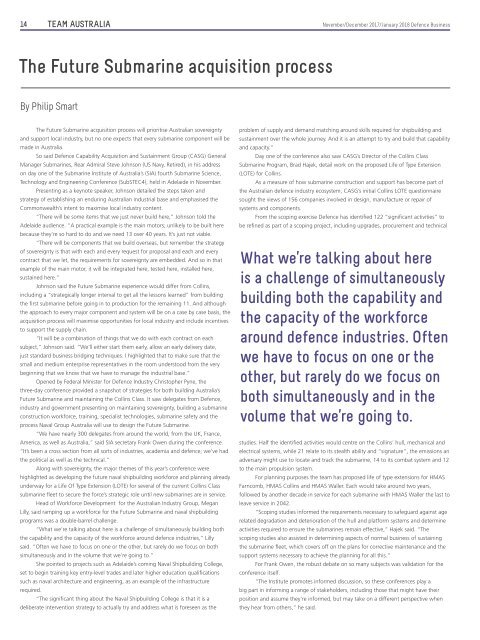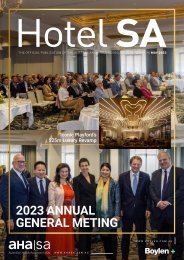Defence Business Issue 41
Create successful ePaper yourself
Turn your PDF publications into a flip-book with our unique Google optimized e-Paper software.
TEAM AUSTRALIA<br />
14 November/December 2017/January 2018 <strong>Defence</strong> <strong>Business</strong><br />
The Future Submarine acquisition process<br />
By Philip Smart<br />
The Future Submarine acquisition process will prioritise Australian sovereignty<br />
and support local industry, but no one expects that every submarine component will be<br />
made in Australia.<br />
So said <strong>Defence</strong> Capability Acquisition and Sustainment Group (CASG) General<br />
Manager Submarines, Rear Admiral Steve Johnson (US Navy, Retired), in his address<br />
on day one of the Submarine Institute of Australia’s (SIA) fourth Submarine Science,<br />
Technology and Engineering Conference (SubSTEC4), held in Adelaide in November.<br />
Presenting as a keynote speaker, Johnson detailed the steps taken and<br />
strategy of establishing an enduring Australian industrial base and emphasised the<br />
Commonwealth’s intent to maximise local industry content.<br />
“There will be some items that we just never build here,” Johnson told the<br />
Adelaide audience. “A practical example is the main motors; unlikely to be built here<br />
because they’re so hard to do and we need 13 over 40 years. It’s just not viable.<br />
“There will be components that we build overseas, but remember the strategy<br />
of sovereignty is that with each and every request for proposal and each and every<br />
contract that we let, the requirements for sovereignty are embedded. And so in that<br />
example of the main motor, it will be integrated here, tested here, installed here,<br />
sustained here.”<br />
Johnson said the Future Submarine experience would differ from Collins,<br />
including a “strategically longer interval to get all the lessons learned” from building<br />
the first submarine before going in to production for the remaining 11. And although<br />
the approach to every major component and system will be on a case by case basis, the<br />
acquisition process will maximise opportunities for local industry and include incentives<br />
to support the supply chain.<br />
“It will be a combination of things that we do with each contract on each<br />
subject,” Johnson said. “We’ll either start them early, allow an early delivery date,<br />
just standard business bridging techniques. I highlighted that to make sure that the<br />
small and medium enterprise representatives in the room understood from the very<br />
beginning that we know that we have to manage the industrial base.”<br />
Opened by Federal Minister for <strong>Defence</strong> Industry Christopher Pyne, the<br />
three-day conference provided a snapshot of strategies for both building Australia’s<br />
Future Submarine and maintaining the Collins Class. It saw delegates from <strong>Defence</strong>,<br />
industry and government presenting on maintaining sovereignty, building a submarine<br />
construction workforce, training, specialist technologies, submarine safety and the<br />
process Naval Group Australia will use to design the Future Submarine.<br />
“We have nearly 300 delegates from around the world, from the UK, France,<br />
America, as well as Australia,” said SIA secretary Frank Owen during the conference.<br />
“It’s been a cross section from all sorts of industries, academia and defence; we’ve had<br />
the political as well as the technical.”<br />
Along with sovereignty, the major themes of this year’s conference were<br />
highlighted as developing the future naval shipbuilding workforce and planning already<br />
underway for a Life Of Type Extension (LOTE) for several of the current Collins Class<br />
submarine fleet to secure the force’s strategic role until new submarines are in service.<br />
Head of Workforce Development for the Australian Industry Group, Megan<br />
Lilly, said ramping up a workforce for the Future Submarine and naval shipbuilding<br />
programs was a double-barrel challenge.<br />
“What we’re talking about here is a challenge of simultaneously building both<br />
the capability and the capacity of the workforce around defence industries,” Lilly<br />
said. “Often we have to focus on one or the other, but rarely do we focus on both<br />
simultaneously and in the volume that we’re going to.”<br />
She pointed to projects such as Adelaide’s coming Naval Shipbuilding College,<br />
set to begin training key entry-level trades and later higher education qualifications<br />
such as naval architecture and engineering, as an example of the infrastructure<br />
required.<br />
“The significant thing about the Naval Shipbuilding College is that it is a<br />
deliberate intervention strategy to actually try and address what is foreseen as the<br />
problem of supply and demand matching around skills required for shipbuilding and<br />
sustainment over the whole journey. And it is an attempt to try and build that capability<br />
and capacity.”<br />
Day one of the conference also saw CASG’s Director of the Collins Class<br />
Submarine Program, Brad Hajek, detail work on the proposed Life of Type Extension<br />
(LOTE) for Collins.<br />
As a measure of how submarine construction and support has become part of<br />
the Australian defence industry ecosystem, CASG’s initial Collins LOTE questionnaire<br />
sought the views of 156 companies involved in design, manufacture or repair of<br />
systems and components.<br />
From the scoping exercise <strong>Defence</strong> has identified 122 “significant activities” to<br />
be refined as part of a scoping project, including upgrades, procurement and technical<br />
What we’re talking about here<br />
is a challenge of simultaneously<br />
building both the capability and<br />
the capacity of the workforce<br />
around defence industries. Often<br />
we have to focus on one or the<br />
other, but rarely do we focus on<br />
both simultaneously and in the<br />
volume that we’re going to.”<br />
studies. Half the identified activities would centre on the Collins’ hull, mechanical and<br />
electrical systems, while 21 relate to its stealth ability and “signature”, the emissions an<br />
adversary might use to locate and track the submarine, 14 to its combat system and 12<br />
to the main propulsion system.<br />
For planning purposes the team has proposed life of type extensions for HMAS<br />
Farncomb, HMAS Collins and HMAS Waller. Each would take around two years,<br />
followed by another decade in service for each submarine with HMAS Waller the last to<br />
leave service in 2042.<br />
“Scoping studies informed the requirements necessary to safeguard against age<br />
related degradation and deterioration of the hull and platform systems and determine<br />
activities required to ensure the submarines remain effective,” Hajek said. “The<br />
scoping studies also assisted in determining aspects of normal business of sustaining<br />
the submarine fleet, which covers off on the plans for corrective maintenance and the<br />
support systems necessary to achieve the planning for all this.”<br />
For Frank Owen, the robust debate on so many subjects was validation for the<br />
conference itself.<br />
“The Institute promotes informed discussion, so these conferences play a<br />
big part in informing a range of stakeholders, including those that might have their<br />
position and assume they’re informed, but may take on a different perspective when<br />
they hear from others,” he said.


















